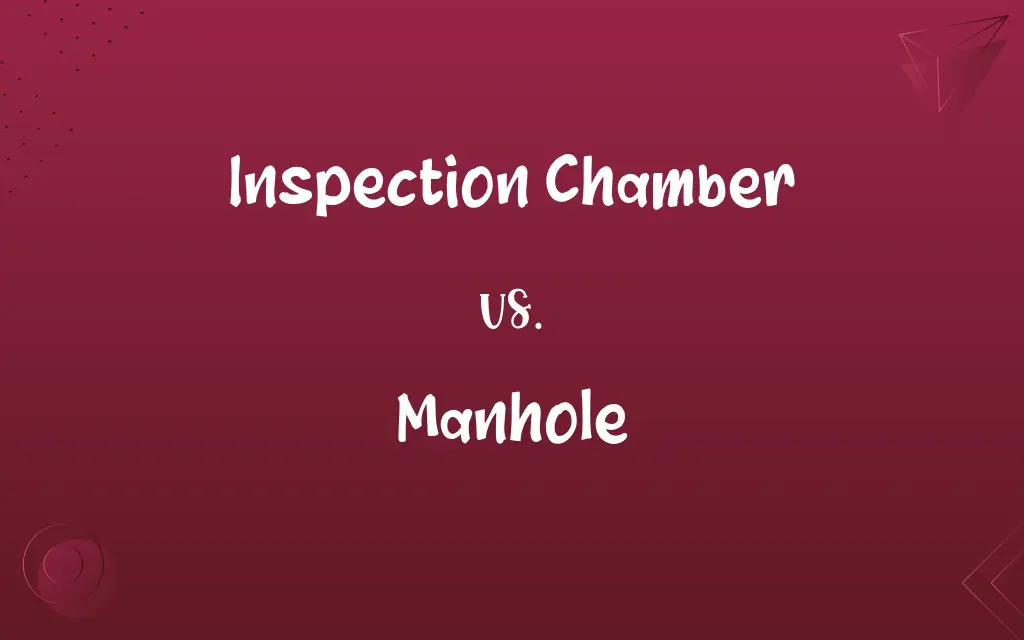Inspection Chamber vs. Manhole: Know the Difference

By Shumaila Saeed & Hifza Nasir || Published on November 8, 2024
Inspection chambers and manholes are crucial for sewer and drainage system maintenance, with chambers used for minor access and inspections, and manholes allowing full entry for major repairs.

Key Differences
Inspection chambers and manholes are essential components of underground utility systems, facilitating access for inspection, maintenance, and repair. Inspection chambers, smaller in size, are designed for quick checks and minor maintenance, typically accessed with tools rather than personnel entry. They are often found in residential or light traffic areas, connecting smaller diameter pipes. Manholes, on the other hand, are larger structures that permit personnel to enter and perform extensive repairs or cleaning. They are constructed to withstand heavy traffic loads and connect larger sewer or drainage pipes, making them suitable for commercial and industrial areas.
Shumaila Saeed
Nov 08, 2024
The choice between an inspection chamber and a manhole depends on the system's requirements, such as the depth of the installation, the diameter of connecting pipes, and the anticipated maintenance needs. Inspection chambers offer a cost-effective solution for systems requiring only occasional maintenance or inspection from the surface. In contrast, manholes, due to their size and accessibility for humans, are necessary for comprehensive system checks and significant repairs, including the removal of blockages and infrastructure upgrades.
Hifza Nasir
Nov 08, 2024
Inspection chambers are typically limited to depths of around 600mm to 1200mm, manholes can be installed at much greater depths, providing access to deeper sewer lines. The construction of manholes is more labor-intensive and costly, reflecting their role in maintaining larger and more complex systems. Despite these differences, both inspection chambers and manholes play a vital role in ensuring the efficiency, safety, and longevity of sewer and drainage systems.
Hifza Nasir
Nov 08, 2024
The integration of inspection chambers and manholes into a utility infrastructure highlights a balanced approach to system design, allowing for efficient maintenance and minimizing disruptions. This combination ensures that while routine inspections are easily manageable through inspection chambers, more significant issues can be addressed through manholes, thereby maintaining the overall health and functionality of underground utility networks.
Shumaila Saeed
Nov 08, 2024
Comparison Chart
Installation Depth
Typically up to 1.2 meters for shallow access.
Can exceed 1.2 meters for deep sewer systems.
Hifza Nasir
Nov 08, 2024
ADVERTISEMENT
Location
Residential areas, light traffic zones.
Commercial, industrial areas, under heavy traffic.
Shumaila Saeed
Nov 08, 2024
Pipe Diameter
Connects smaller diameter pipes.
Suitable for larger sewer or drainage pipes.
Hifza Nasir
Nov 08, 2024
Accessibility
Accessed with tools, not designed for human entry.
Designed for human entry and maintenance work.
Shumaila Saeed
Nov 08, 2024
Construction Cost
Less expensive due to smaller size and simpler construction.
More expensive, labor-intensive construction.
Hifza Nasir
Nov 08, 2024
Maintenance
Ideal for systems requiring surface-level maintenance.
Necessary for comprehensive system management.
Shumaila Saeed
Nov 08, 2024
ADVERTISEMENT
Traffic Load
Not designed to withstand heavy traffic loads.
Built to withstand heavy traffic loads.
Hifza Nasir
Nov 08, 2024
Use Case
Cost-effective for minor inspections and maintenance.
Required for full system access and major repairs.
Shumaila Saeed
Nov 08, 2024
Inspection Chamber and Manhole Definitions
Inspection Chamber
Designed for minor, surface-level maintenance.
Clearing minor blockages can often be done through an inspection chamber.
Hifza Nasir
Feb 29, 2024
Manhole
Necessary for the safety and efficiency of large networks.
Regular inspections and cleaning through manholes prevent system failures.
Dua Fatima
Feb 29, 2024
Inspection Chamber
Accessed using rods or cameras, not for human entry.
Plumbers use cameras through inspection chambers to locate leaks.
Shumaila Saeed
Feb 29, 2024
ADVERTISEMENT
Manhole
A large underground structure for system access.
Manholes on city streets allow workers to enter and repair the sewer system.
Hifza Nasir
Feb 29, 2024
Inspection Chamber
Less costly, reflecting simpler needs.
Adding an inspection chamber provides a cost-effective way to monitor sewer health.
Hifza Nasir
Feb 29, 2024
Manhole
Built for deep and complex systems.
Manholes provide access to the city's main sewer lines for comprehensive maintenance.
Shumaila Saeed
Feb 29, 2024
Inspection Chamber
Suitable for shallow installations.
Inspection chambers are installed where pipe networks are relatively close to the surface.
Hifza Nasir
Feb 29, 2024
Manhole
Designed to handle heavy traffic above.
Manholes in busy intersections are constructed to withstand the pressure of passing vehicles.
Shumaila Saeed
Feb 29, 2024
Inspection Chamber
A small access point for sewer or drainage systems.
Inspection chambers in a residential complex allow for easy sewer system checks.
Shumaila Saeed
Feb 29, 2024
Manhole
Allows personnel to perform in-depth maintenance.
Major blockages and repairs in the sewer are addressed through manholes.
Shumaila Saeed
Feb 29, 2024
Repeatedly Asked Queries
What is the main difference between an inspection chamber and a manhole?
The main difference lies in their size and purpose, with inspection chambers providing surface-level access for minor maintenance, and manholes allowing full entry for extensive system repairs.
Hifza Nasir
Nov 08, 2024
Why are manholes necessary in urban areas?
Manholes are crucial in urban areas for maintaining larger and deeper sewer systems, ensuring public health and environmental safety through regular access for repairs and cleaning.
Shumaila Saeed
Nov 08, 2024
Are there regulations governing the installation of inspection chambers and manholes?
Yes, local building codes and environmental regulations typically dictate the specifications, installation depths, and locations for both inspection chambers and manholes to ensure safety and functionality.
Shumaila Saeed
Nov 08, 2024
How does weather affect the maintenance of inspection chambers and manholes?
Extreme weather conditions, such as heavy rainfall or freezing temperatures, can increase the need for maintenance checks to prevent blockages or damage, with both structures requiring regular inspection to ensure they remain clear and functional.
Shumaila Saeed
Nov 08, 2024
Can an inspection chamber be converted into a manhole?
Generally, due to size and structural differences, an inspection chamber cannot be easily converted into a manhole without significant reconstruction.
Hifza Nasir
Nov 08, 2024
How often should inspection chambers and manholes be checked?
The frequency of checks depends on the system's complexity and usage, with inspection chambers often checked more frequently due to their ease of access, while manholes require scheduled, thorough inspections.
Shumaila Saeed
Nov 08, 2024
What materials are used to construct inspection chambers and manholes?
Inspection chambers and manholes are typically made from durable materials like concrete, plastic (polyethylene or PVC), and, less commonly, brick or fiberglass, chosen for their longevity and resistance to corrosion.
Shumaila Saeed
Nov 08, 2024
What safety precautions are necessary when accessing manholes?
Safety precautions for accessing manholes include wearing appropriate personal protective equipment (PPE), ensuring proper ventilation to prevent toxic gas exposure, using fall protection gear, and implementing lockout/tagout procedures for nearby mechanical and electrical systems.
Hifza Nasir
Nov 08, 2024
Can inspection chambers be used in commercial areas?
While inspection chambers can be installed in commercial areas, their use may be limited to parts of the system with lighter load requirements or where only shallow access is needed, with manholes preferred for main access points due to their durability under heavy traffic.
Shumaila Saeed
Nov 08, 2024
How are inspection chambers and manholes inspected for integrity and damage?
They are inspected using visual checks, CCTV cameras for internal inspection, and, in some cases, testing for structural integrity using methods like smoke testing or dye testing to identify leaks or structural weaknesses.
Shumaila Saeed
Nov 08, 2024
What innovations are being implemented in the design and construction of inspection chambers and manholes?
Innovations include the use of more durable and lightweight materials, smart sensors for real-time monitoring of conditions, and designs that facilitate easier and safer access for maintenance personnel.
Shumaila Saeed
Nov 08, 2024
How do inspection chambers and manholes contribute to environmental protection?
By providing access for the maintenance and repair of underground utility systems, inspection chambers and manholes help prevent leaks and overflows that could contaminate soil and water bodies, thus playing a crucial role in environmental protection.
Shumaila Saeed
Nov 08, 2024
Are there differences in the design of inspection chambers and manholes for stormwater versus wastewater systems?
While the fundamental design principles remain similar, stormwater systems may have larger or more open designs to accommodate higher flow volumes and debris, whereas wastewater systems focus on preventing gas buildup and ensuring tight seals.
Hifza Nasir
Nov 08, 2024
What is the impact of urban development on the planning and placement of inspection chambers and manholes?
Urban development increases the need for strategic planning and placement of inspection chambers and manholes to accommodate higher density living, increased wastewater volumes, and the integration with existing utility networks, requiring careful urban planning and engineering.
Shumaila Saeed
Nov 08, 2024
How does the installation depth of inspection chambers and manholes affect their design and functionality?
The installation depth influences the structural design, with deeper installations requiring stronger materials and designs to withstand soil pressure and groundwater infiltration. It also affects functionality, as deeper systems may need additional features like steps or ladders for access and more robust sealing mechanisms to prevent water ingress.
Hifza Nasir
Nov 08, 2024
Share this page
Link for your blog / website
HTML
Link to share via messenger
About Author
Written by
Shumaila SaeedShumaila Saeed, an expert content creator with 6 years of experience, specializes in distilling complex topics into easily digestible comparisons, shining a light on the nuances that both inform and educate readers with clarity and accuracy.
Co-written by
Hifza Nasir







































































